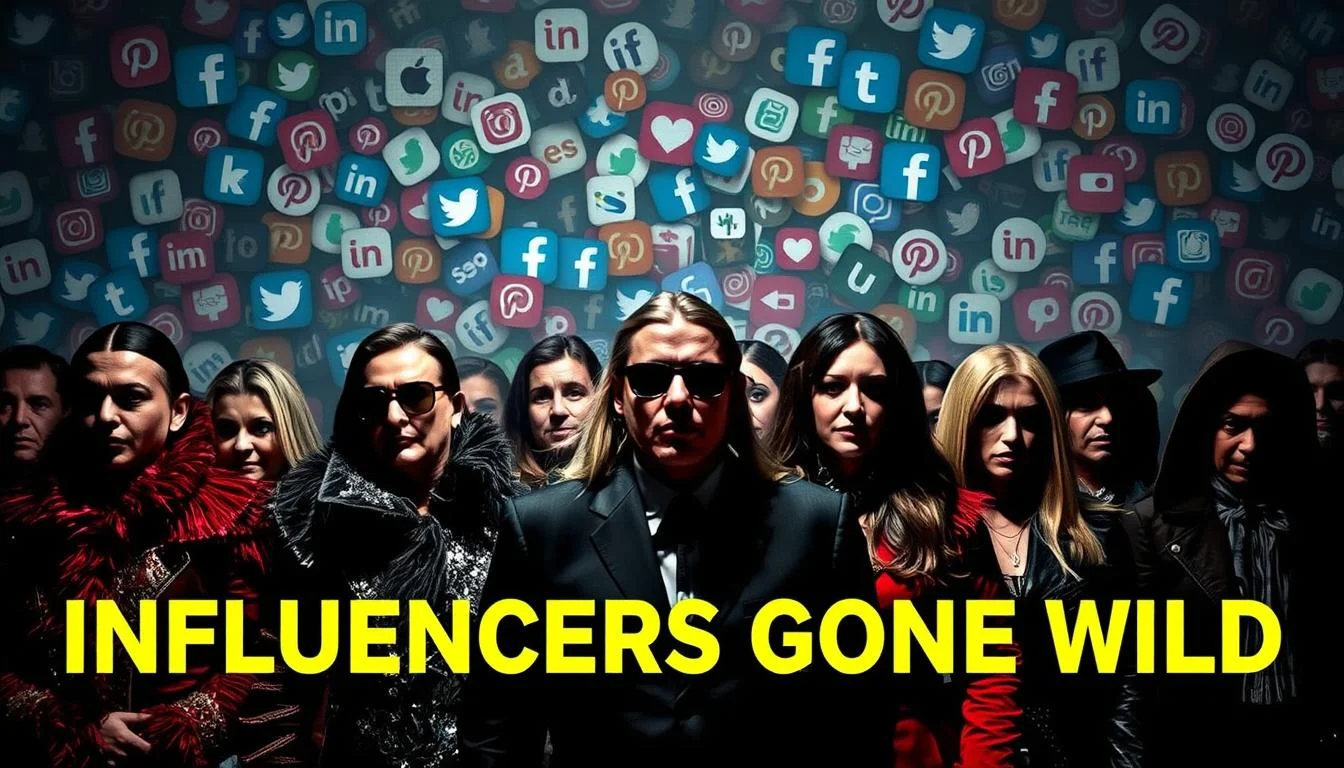Introduction
In today’s digital world, influencers have become household names. Millions of people look to them for product recommendations, lifestyle inspiration, and entertainment. But not every influencer journey is polished or positive. Sometimes, creators push boundaries to the extreme, sparking scandals, backlash, or even legal troubles. This phenomenon is often described as “influencer gone wild.”
It refers to moments when influencers act out in shocking, controversial, or unpredictable ways—whether through reckless stunts, offensive statements, or outrageous publicity moves. While these actions may generate short-term attention, they often come with long-term consequences.
This article explores what happens when influencers go wild, why it occurs, real-world examples, the risks involved, and how audiences and brands can respond wisely.
What Does “Influencer Gone Wild” Really Mean?
The phrase “gone wild” doesn’t just mean being funny or quirky. It signals a dramatic departure from an influencer’s usual content or values. Often, it involves content or behavior designed to shock, provoke, or break rules.
Some examples include:
-
Posting offensive or controversial statements
-
Participating in dangerous challenges or stunts
-
Promoting harmful or deceptive products
-
Publicly feuding with other creators
-
Engaging in scandals, reckless lifestyle choices, or legal issues
For followers, it can feel like a betrayal of trust. For brands, it’s a risk to reputation and partnerships.
Why Do Influencers Go Wild?
Influencers don’t go wild for no reason. Several factors push them toward controversial actions:
1. The Algorithm Effect
Social media platforms reward engagement. The more likes, shares, and comments a post gets, the more visibility it earns. Outrage and shock tend to drive interaction, creating a strong incentive for influencers to “up the drama.”
2. Fear of Losing Relevance
Social media moves fast. Yesterday’s viral star can be forgotten today. Some influencers go wild to keep their names trending and to avoid fading into obscurity.
3. Money and Sponsorship Pressure
The more followers and engagement an influencer has, the higher their potential income. For some, pushing boundaries seems like a shortcut to increased visibility and brand deals.
4. Personal Struggles
Behind the curated feeds, influencers are people too. Stress, burnout, or personal turmoil sometimes spill into the public eye in dramatic ways.
5. Blurred Boundaries
The line between personal life and public persona is thin. When influencers share too much or mix private drama with public content, “wild” situations can easily erupt.
Famous Cases of Influencers Going Wild
Logan Paul’s Controversy
One of the most infamous examples occurred when YouTuber Logan Paul uploaded insensitive content from Japan’s Aokigahara forest. The backlash was swift, leading to loss of brand deals and a damaged reputation.
Belle Delphine’s Stunts
Belle Delphine became internet-famous for her unusual marketing moves, including selling “gamer girl bath water.” While some saw it as creative, others viewed it as outrageous attention-seeking.
Ms. Puiyi’s Image Leak
Malaysian influencer Ms. Puiyi turned a personal privacy crisis into a business strategy by monetizing content on subscription platforms. Her case shows how controversy can reshape careers.
Drama-Driven Influencers
From public feuds on TikTok to reckless stunts on Instagram, countless smaller influencers have gained quick notoriety—only to lose trust once the drama faded.
The Risks of Going Wild
While wild behavior can bring short bursts of fame, the risks almost always outweigh the rewards.
1. Damaged Reputation
One viral scandal can undo years of credibility. Followers may unfollow, criticize, or boycott the influencer.
2. Lost Partnerships
Brands avoid controversy. When an influencer misbehaves, companies often end contracts to protect their image.
3. Financial Fallout
Loss of sponsorships, demonetization, or platform bans can lead to sudden income drops.
4. Legal Trouble
Extreme stunts, false advertising, or offensive content may attract lawsuits or government penalties.
5. Mental Health Impact
Facing backlash from millions of people can take a heavy emotional toll, leading to anxiety, depression, or burnout.
6. Harm to Followers
Audiences—especially young fans—may imitate dangerous or unhealthy behaviors. This makes the impact of wild influencer actions more widespread than just their personal brand.
How Audiences Can Respond
Followers play a big role in shaping influencer culture. Here’s how audiences can protect themselves:
-
Think critically: Don’t assume everything posted online is genuine or safe.
-
Don’t imitate recklessness: Avoid copying stunts or challenges that could harm you.
-
Hold influencers accountable: Unfollow or speak out when creators cross ethical lines.
-
Support positive voices: Choose to engage with influencers who inspire, educate, or entertain responsibly.
How Brands Should Handle Influencer Partnerships
For businesses, influencer marketing is powerful but risky. To minimize damage:
-
Research thoroughly: Review an influencer’s past content and reputation before collaborating.
-
Set clear contracts: Include clauses that allow ending partnerships if scandals arise.
-
Look beyond numbers: Choose influencers who align with brand values, not just follower counts.
-
Plan ahead: Have crisis management strategies ready in case of unexpected controversy.
Tips for Influencers to Avoid Going Wild
Influencers themselves can take proactive steps to balance authenticity with responsibility:
-
Set boundaries: Decide what you will and won’t post before temptation strikes.
-
Reflect regularly: Check if your content aligns with your mission and audience expectations.
-
Seek accountability: Surround yourself with advisors or trusted peers who give honest feedback.
-
Focus on long-term impact: Viral stunts may fade, but meaningful influence builds lasting credibility.
-
Take breaks: Avoid burnout by stepping back from constant content creation when needed.
The Bigger Picture
The trend of “influencer gone wild” highlights deeper truths about today’s culture:
-
Attention is currency: Outrage and shock often feel more valuable than calm, thoughtful content.
-
Boundaries are blurred: The line between entertainment and exploitation is thinner than ever.
-
Platforms hold power: Social networks amplify or suppress content, shaping what behavior is rewarded.
-
Shared responsibility matters: Audiences, brands, platforms, and influencers must all play a role in setting healthier standards.
Ultimately, this isn’t just about influencers acting out—it’s about how digital culture rewards or rejects certain behaviors.
Read More: Social Media Girl Forums: Safe Use, Benefits & Risks
Conclusion
The phrase “influencer gone wild” captures the dangers of mixing fame, pressure, and a craving for relevance in today’s digital world. While outrageous actions may draw temporary attention, they often leave behind long-lasting damage—lost trust, broken partnerships, and emotional distress.
Influencers hold real power to shape opinions, lifestyles, and trends. That power comes with responsibility. Audiences must demand accountability, brands must partner wisely, and creators themselves must balance authenticity with ethics. Going wild might spark headlines, but it rarely builds a sustainable career.
The future of influencer culture depends on moving away from reckless sensationalism and toward meaningful, value-driven content. Influence works best not when it shocks or manipulates, but when it informs, inspires, and connects.
FAQs
1. What does “influencer gone wild” mean?
It refers to influencers behaving in shocking, reckless, or controversial ways that break from their usual brand identity.
2. Why do influencers act out online?
They may seek relevance, algorithmic attention, financial gain, or may be struggling personally.
3. What risks do influencers face when they go wild?
They risk damaged reputations, lost sponsorships, financial setbacks, mental health struggles, and even legal issues.
4. How should brands choose influencers carefully?
By researching their past, setting clear contracts, and prioritizing long-term value alignment over short-term fame.
5. What can audiences do when influencers misbehave?
Audiences can unfollow, call out harmful behavior, and support creators who act responsibly and add positive value.










